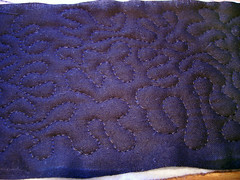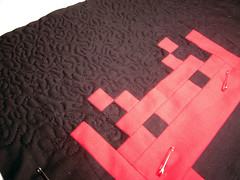My Second Free Motion Stippling Trial
So I've stitched in the ditch and used a basic diagonal quilting technique. Neither of these techniques are going to work on the Invaders as it is mostly black so necessity is forcing me to learn how to free motion stipple.
It is a very intimidating technique to begin. The first thing is to create a practice quilt sandwich. Two practice strips later I am still too tense and a little jerky, but feel I could begin a larger piece.
First change to your darning foot and then you want to get your tension right. Do a little test patch then look at the back of your work. If there are loops being formed on the underside increase the tension - I had to increase my top tension up a lot - and try again. Once your tension is right, adjust your speed to a comfortable setting. I have reduced my speed to half way which is not too fast, but not too slow for me either. Now you're ready to practice.
The best technique I found is to try to make two curves on one side and then two in the other direction. Move the fabric around and with a little practice you should see a random pattern emerging. Try to keep your spacing even and try not to overlap any stitching you have already done. If you are right handed work from left to right. When you get to the right hand side turn your fabric either 90 or 180 degrees and keep going. You could also find a diagram of a simple stipple online and practice drawing it on paper to learn the curves you want to achieve.
Quilting on Invaders Started
Another top tip: Don't forget to lower the foot on your machine or you won't be able to sew at all I actually forgot this myself as my darning foot doesn't sit right down on the fabric like a normal presser foot so it is difficult to tell if it is up or down at a glance.
Great Video Tutorial by Leah Day



No comments:
Post a Comment